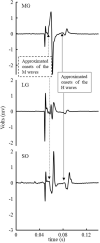The effect of loss of foot sole sensitivity on H-reflex of triceps surae muscles and functional gait
- PMID: 36685170
- PMCID: PMC9849679
- DOI: 10.3389/fphys.2022.1036122
The effect of loss of foot sole sensitivity on H-reflex of triceps surae muscles and functional gait
Abstract
Objective: To investigate the effects of foot sole insensitivity on the outcomes of the triceps surae muscle H-reflex and functional gait. Material and Methods: People with peripheral neuropathy were recruited and divided into two groups: people with more (n = 13, 73.3 ± 4.3 years old) or less (n = 10, 73.5 ± 5.3) sensitive tactile sensation. Their monofilament testing scores were 9.0 ± 1.5 (range: 7-10) and 2.3 ± 2.4 (range: 0-6) out of 10, respectively. H-reflex of the triceps surae muscles during quiet standing and their relationship with functional gait, 6 min walking distance (6MWD), and timed-up-and-go duration (TUG), were compared between groups. Results: No significant difference was detected for H-reflex parameters between the groups. The less sensitive group showed reduced (p < .05) functional gait capacity compared to the other group, 38.4 ± 52.7 vs. 463.5 ± 47.6 m for 6MWD, and 9.0 ± 1.5 vs. 7.2 ± 1.1s for TUG, respectively. A significant correlation (p < .05), worse functional gait related to greater H/M ratio, was observed in the less sensitive group, not the other group. Conclusion: Although there was no significant H-reflex difference between the groups, more pronounced tactile sensation degeneration affected functional gaits and their relationship with H-reflex.
Keywords: H-reflex; foot sole sensitivity; functional gait; motor control; triceps surae muscles.
Copyright © 2023 Zhang, Sun, Qu, Lewis, Choi, Song and Li.
Conflict of interest statement
The authors declare that the research was conducted in the absence of any commercial or financial relationships that could be construed as a potential conflict of interest.
Figures






Similar articles
-
H-index is important for postural control for people with impaired foot sole sensation.PLoS One. 2015 Mar 25;10(3):e0121847. doi: 10.1371/journal.pone.0121847. eCollection 2015. PLoS One. 2015. PMID: 25807534 Free PMC article.
-
Contributions to the understanding of gait control.Dan Med J. 2014 Apr;61(4):B4823. Dan Med J. 2014. PMID: 24814597 Review.
-
The Reduced Adaptability of H-Reflex Parameters to Postural Change With Deficiency of Foot Plantar Sensitivity.Front Physiol. 2022 Jun 29;13:890414. doi: 10.3389/fphys.2022.890414. eCollection 2022. Front Physiol. 2022. PMID: 35846020 Free PMC article.
-
Fusimotor reflexes in triceps surae muscle elicited by stretch of muscles in the contralateral hind limb of the cat.J Physiol. 1986 Apr;373:419-41. doi: 10.1113/jphysiol.1986.sp016056. J Physiol. 1986. PMID: 3746678 Free PMC article.
-
Stretch reflexes of triceps surae in normal man.J Neurol Neurosurg Psychiatry. 1982 Jun;45(6):513-25. doi: 10.1136/jnnp.45.6.513. J Neurol Neurosurg Psychiatry. 1982. PMID: 7119814 Free PMC article.
Cited by
-
Effects of Reflexology on Anorexia and Sleep Quality in Patients Undergoing Chemotherapy: A Randomized Clinical Trial.Iran J Nurs Midwifery Res. 2024 Jul 2;29(3):337-342. doi: 10.4103/ijnmr.ijnmr_62_23. eCollection 2024 May-Jun. Iran J Nurs Midwifery Res. 2024. PMID: 39100404 Free PMC article.
References
-
- Alfuth M., Rosenbaum D. (2012). Effects of changes in plantar sensory feedback on human gait characteristics: A systematic review. Footwear Sci. 4 (1), 1–22. 10.1080/19424280.2011.653990 - DOI
LinkOut - more resources
Full Text Sources

